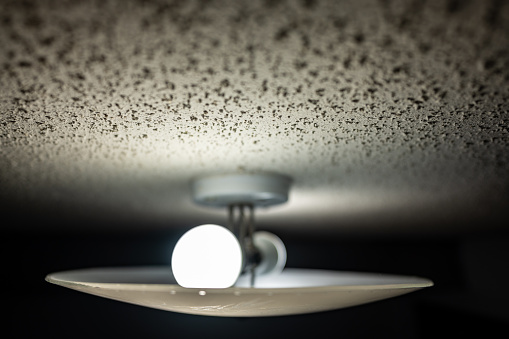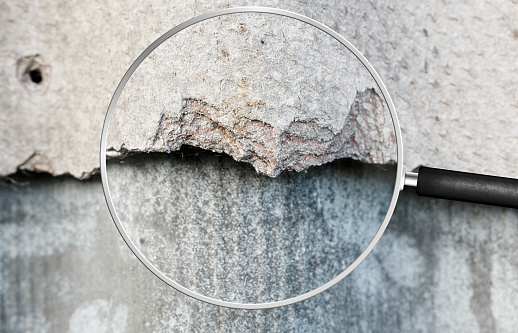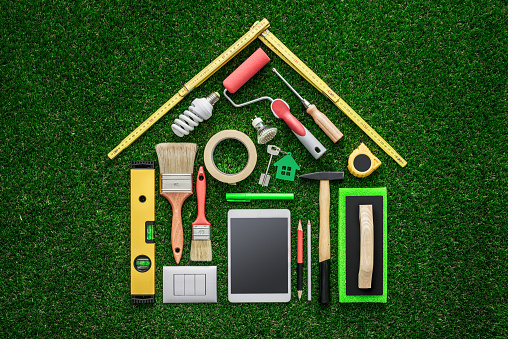
Popcorn ceiling removal is a popular home improvement project many homeowners tackle. Popcorn ceilings, also known as acoustic or stucco ceilings, were once a popular trend in interior design due to their ease of installation and ability to absorb sound. However, the rough texture attracts dust and can be difficult to clean.
Stipple ceilings are being removed or covered by many households because, like many trends in the1970s, they are ugly.
If you find yourself staring upward and wondering how to get rid of popcorn ceilings, you are not alone. We shall begin by discussing the cost of removing an acoustic roof. If you’re looking for easy methods to remove your popcorn ceiling, there are a few easy methods to do so.
How Much Does it Cost to Remove Popcorn Ceiling?
According to Home Advisor, the average cost of stipple ceiling removal is around $1,707 nationally. It is important to consider engaging the services of a licensed professional to remove popcorn ceilings safely, as the process can be labor-intensive and may involve asbestos or amosite. Before starting the project, it’s always a good idea to have a professional assess the ceiling for asbestos.
What is the best method for removing popcorn ceilings?

To determine the best method for removing stucco ceilings depends on various factors such as the age and condition of the ceiling. There are three methods for undoing popcorn roofs, and a professional licensed in drywall and stucco can provide guidance.
The three methods include wet scraping, dry scraping, and spray and scrape. When removing acoustic ceilings, it’s important to take appropriate safety measures, such as wearing facial dust gear, eye protection, and other necessary gear. Before starting the project, homeowners should consult a professional, as there may be asbestos in the ceiling. The result will be a newly smooth ceiling, which can be painted or a new layer of wallboard added.
How to Scrape a Popcorn Ceiling
Scraping a popcorn ceiling is a common method of removing the textured finish, but it can be messy and slow. If your ceiling has a risk of containing asbestos or lead paint, it’s important to test it before proceeding with removal. If it tests positive, do not scrape the ceiling. If the ceiling has been painted, it may be difficult to scrape as the porous popcorn material may have absorbed it.
A drywall taping knife or a 4-inch utility knife can be used to chip away at the texture and create a smooth surface, but it’s best to scrape the ceiling dry without spraying it with water as it may cause the ceiling to absorb moisture and expand. After scraping, a thin layer of joint compound may need to be applied to smooth out imperfections, followed by sanding before repainting. Remember to wear appropriate safety gear when removing a popcorn ceiling, such as a mask and eye protection.
How to Cover up with Drywall

Another easy method to remove your popcorn ceiling is to cover it with a wallboard. Ceiling-grade gypsum board, which is lighter than standard wallboard, can be affixed directly over your existing popcorn ceiling. To do so, you’ll need to screw it securely into the framing and have the skills to mud and tape for a seamless finish. This is better than scraping if your ceiling has lead paint or amosite, as it encapsulates the harmful substance.
Additionally, if your ceiling has damage or needs electrical or HVAC rerouting, large cuts can be made into the existing substrate without patching.
However, keep in mind that this option can be pricey, with a 4×8-foot sheet of ceiling-grade gypsum board costing around $9. Maneuvering the boards alone can also be difficult if you do the job yourself. Renting a drywall lift ($40 per day at The Home Depot) can make the process easier and safer. It may need to be removed and replaced if you have crown molding.
Skim Coat on a New Design
Creating a newly textured ceiling, known as skim coating, is making a comeback and is fairly simple for homeowners. Often found in older homes pre-popcorn era, this process involves cleaning and preparing the existing substrate with quick-set drywall mud, applying a bonding agent such as joint compound, and then using a trowel or knife to apply a finishing compound for a new texture. This can be an alternative for those looking to remove popcorn ceilings.
Procedures for removing Popcorn Ceiling
If you now know the three easy methods to remove popcorn ceilings, then you also want to be sure you understand the procedure. Here is a step-by-step guide to undoing popcorn roofs.
Test for Asbestos Before You Begin Popcorn Ceiling Removal

Popcorn ceiling removal is a popular home improvement job, as many homeowners look to update their interior design. However, before starting, it’s important to ensure your textured popcorn ceilings do not contain asbestos, which was used in many ceilings prior to the 1980s.
A professional licensed in asbestos control or a DIY test kit from the hardware store can be used to test the surface. Wearing appropriate safety gear, such as gloves, a ventilator or dusk mask, and an eye protector, are essential when performing the test or removing the stipple ceiling.
It’s important to ensure that your textured ceilings don’t have asbestos. If your ceiling tests positive for amosite, it’s best to have a professional handle the removal or cover the entire ceiling with paneling or new drywall. If it’s in good condition, there’s no danger in leaving the ceiling intact.
Gather Your Tools

If you have confirmed that your textured ceiling does not contain asbestos, it’s time to gather your tools to remove the roof’s texture. A garden sprayer or pump sprayer for spraying water, a wide putty knife or drywall knife, drop cloths or plastic sheeting to cover the floor with, painter’s tape, a ladder, safety goggles, and a facial dust gear are the essential tools you’ll need for a successful stipple ceiling removal project.
These items are readily available, and many homeowners may already have them on hand. Make sure to have all the necessary tools and protective gear before removing the existing popcorn ceiling.
Protect Walls, Floors, and Yourself
When detaching popcorn ceilings, it is important to take safety measures to protect the walls, floors, and yourself. Have ample drop cloths and plastic sheeting to cover the floors and walls, securing it with painter’s tape. Remove any furniture from the room and cover electrical boxes with painter’s tape. Turn off the electricity and HVAC system in the room and keep windows open to allow for ventilation.
Wearing facial protective gear is essential, and plan for a long project that may take 20 hours for experienced DIYers or professionals to remove 500 sq ft of popcorn ceiling. For those with less experience, it may take longer and can be physically demanding, so take breaks to avoid overexertion. Before starting, make sure to turn off the electricity in the room and keep it ventilated.
Spray the Ceiling With Water Before Carefully Scraping Away the Popcorn Texture

To make the removal of popcorn ceiling easier, it is recommended to wet down the ceiling. Use a garden sprayer or a spray bottle to wet a small ceiling area (four-by-four-foot). Do not soak the ceiling, as too much water could damage the wallboard beneath. Wait for about 15 minutes to let the water absorb, and then start scraping using a wide putty knife or drywall knife. Move the knife gently along the wet ceiling to remove the stucco texture. Work in small sections to prevent areas from drying before reaching them. You may need to make a second pass in some areas, in which case you can respray the ceiling to help loosen the texture. Remember to wear protective gear, such as a dust mask and eye guard, while removing the stipple ceiling.
Once the entire ceiling is free of the popcorn texture, you can start sanding to create a smooth surface. You can then prime and paint the ceiling for a fresh, new look. If you’re unsure about removing popcorn roofs yourself, it is always recommended to consult a licensed professional for home building or asbestos abatement for safety reasons.
Sand, prime, and paint the ceiling
Before starting, make sure to wear protective gear, like a dust mask and eye protective gear. If your ceiling tests positive for asbestos, it’s best to seek help from a licensed professional in asbestos abatement.
Start by covering the floor and walls with drop cloths. Then, using a spray bottle or garden sprayer, gently run water over the popcorn texture to soften it up. You can then use a wide putty knife or drywall taping knife to start scraping off all the texture.
If the texture is still rough, you can sand it down with sandpaper. If the texture is painted, you may be able to dry scrape it first to reveal some of the unpainted texture and then wet scrape the surface.
Once you’ve removed all the texture, repair any damage to the drywall, like visible joints or screws, with a joint compound. Use a putty knife to smooth out the surface. After sanding the roof, prime it with a great fire retardant and give it a fresh coat of paint.
When the paint job is complete, remove the plastic sheeting and reinstall any ceiling fans or electrical boxes. Enjoy your newly smooth ceiling, which will improve the interior design of your room and help absorb sound better. Formerly, the popcorn-like texture was used to help home builders deal with sound travel, and it was a great fire retardant.
Taking down popcorn roofs is a DIY test route for some homeowners, and with the right tools and protective gear, it can be a fairly easy home improvement job. However, if you prefer, you can also opt to have professional home builders do the job for you.
Covering Up Old Popcorn Ceilings

If you are looking for an alternative to removing the existing popcorn texture on your ceilings, other options are available. Installing a new layer of drywall is possible, but there are also easier options to consider, such as faux tin tiles or wood paneling. Attach the tiles or paneling to the ceiling with construction adhesive or a nail gun, but make sure to install furring strips first if the ceiling is highly textured to ensure an even look.
Keep in mind that you will still need to test for amosite before proceeding with any work. If you do choose to remove the popcorn ceiling, make sure to use protective gear. Always follow proper safety guidelines and procedures.
Popcorn Ceiling FAQ
Can I remove my popcorn ceiling myself?
Yes, you can remove your popcorn ceiling yourself. However, it is a messy and time-consuming task that requires appropriate safety gear, such as a dust mask, eye protection, and possibly even asbestos abatement equipment if your ceiling tests positive for asbestos. You will also need tools such as a putty knife, a drywall taping knife, and a garden sprayer or pump sprayer for wet scraping. Before starting, you should also make sure to cover the floor and any furniture with plastic sheeting and drop cloths. If you’re not comfortable with the process or want to ensure it is done safely and efficiently, you may want to consider hiring a professional licensed home builder or contractor.
Why is my popcorn ceiling hard to remove?
There are several reasons why popcorn ceilings can be hard to remove:
1. Age: Over time, the texture on the ceiling can become more difficult to remove as it becomes harder and more firmly adhered to the surface.
2. Type of texture: Some popcorn ceiling textures were made with materials that are more difficult to remove, such as heavy-duty sprays or mixtures containing asbestos.
3. Surface material: Some surfaces, such as gypsum board, can be more challenging to remove popcorn from than others.
4. Method of application: The method used to apply the texture can affect how difficult it is to remove. If the texture is sprayed in thick layers, it can be more challenging to remove.
5. Room conditions: The conditions in the room can also impact the difficulty of removal. If the ceiling is in a humid area, the texture may have absorbed moisture, making it harder to remove.
It is important to seek professional help if you are unsure how to safely remove popcorn ceiling texture, especially if it contains asbestos.
